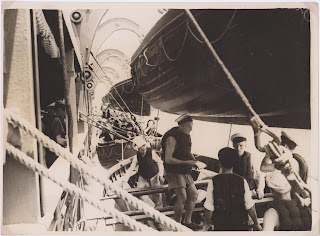Fotografía. Buque de transporte. Segunda guerra mundial. WWII. On board a troops transport. British official photograph
Al dorso de la foto nos indica que nos encontramos ante un buque de crucero civil, de recreo, utilizado durante la segunda guerra mundial para el transporte de tropas.
La foto hace referencia a que dichos barcos, en los momentos de descanso, tenian algunas posibilidades de entretenimiento por su carácter civil como este caso en el cual los marineros estan en los botes de salvamento.
Curiosa foto que casi, si no nos lo indican, no sabemos que es de guerra.
Collections listing for "part of "WAR OFFICE SECOND WORLD WAR OFFICIAL COLLECTION""
“British Official photograph” photographs are divided into different series.
Each photograph has a title and a legend at the back that describes the image and a number always prefixed with a letter.
The letter/s are:
E series photographs (British Army in North Africa and the Middle East) were taken by: No. 1 Army Film and Photographic Unit
BU and B series photographs (Allied forces in North West Europe) were taken by: No. 5 Army Film and Photographic Unit
SE series (Allied forces in South East Asia) photographs were taken by: No. 9 Army Film and Photographic Unit
Each photograph has a title and a legend at the back that describes the image and a number always prefixed with a letter.
The letter/s are:
E series photographs (British Army in North Africa and the Middle East) were taken by: No. 1 Army Film and Photographic Unit
BU and B series photographs (Allied forces in North West Europe) were taken by: No. 5 Army Film and Photographic Unit
SE series (Allied forces in South East Asia) photographs were taken by: No. 9 Army Film and Photographic Unit
- H series (British Army in Britain) photographs were taken by War Office Official Photographers.
- A series (Admiralty Official Collection) photographs were taken by Royal Navy Official Photographers
- C series (Air Ministry Official Collection) photographs were taken by Royal Air Force Official Photographers
-
GM series (British forces in Gibraltar and Malta) photographs were taken by War Office Official Photographers.
-
Some photographer’s names of these photographs shown here are:
Capt. Horton, Capt. Keating, Lt. Cash, Sgt. Flack, Lt. C. J. Ware, Sgt. Laing, Lt. Spender, Lt. Taylor, Sgt. Oakes, Capt. d'Eyncourt, Lt. D. C. Oulds, Sgt. Midgley, Lt. O'Brien, Capt. Gade, Lt. L. Pelman, Sub Lt. D. W. Cooksey, Lt. Vanderson & Sgts. Chetwyn, R.H. Morris & G. Morris, Lts. McLaren & Mayne & Sgt. Slade, Sgt. Morris, Lt. J. E. RussellSgt. J. Deakin, Sgt. Taylor, No 9 Army Film & Photographic Unit, Sgt. Chetwyn, Lt R G G Coote.
-
otros Links
- http://www.iwm.org.uk/
- http://www.afpu.co.uk/
- Imperial War Museum Search photographsMuseo Imperial Britanico de la Guerra Busqueda de fotografias
- You can explore a catalogue of over 600,000 items in our collections here - pretty much everything in our databases in fact. There are items from aircraft down to shoes, photographs and art, weapons and toys, films, interviews and music, posters and letters, books from the library and records in the museum's own archives. Almost 90,000 of them have digitised images, sound or video that you can see and hear right here.
- When war broke out in September 1939, just one Army photographer,
Geoffrey Keating, and one cameraman, Harry Rignold, accompanied the
British Expeditionary Force to France.
On 24 October 1941, the Army agreed to form a corps of trained photographers and cameramen. The unit was called the Army Film and Photographic Unit (AFPU). AFPU photographers and cameramen were recruited from the ranks of the Army. Many had been press photographers or cameramen in peacetime. All recruits had to undergo compulsory training in battle photography at Pinewood Film Studios. Badges and permits were issued after attempts to confiscate film by overzealous British soldiers

